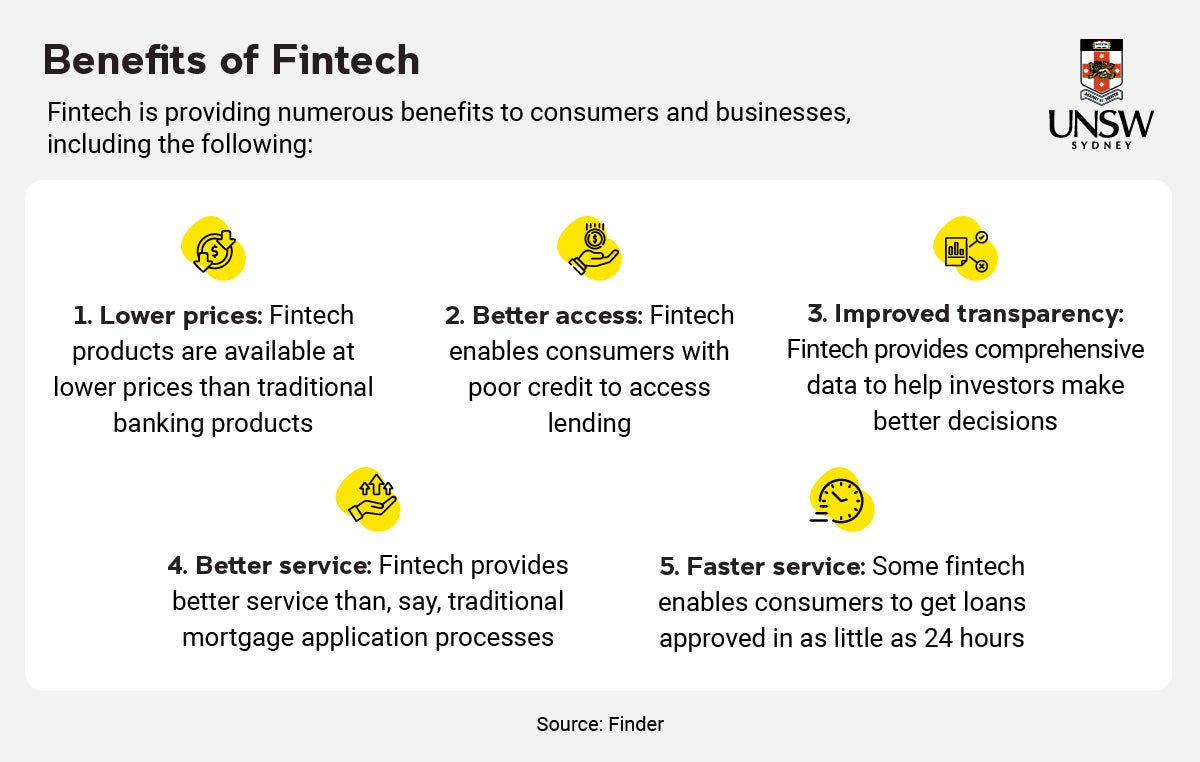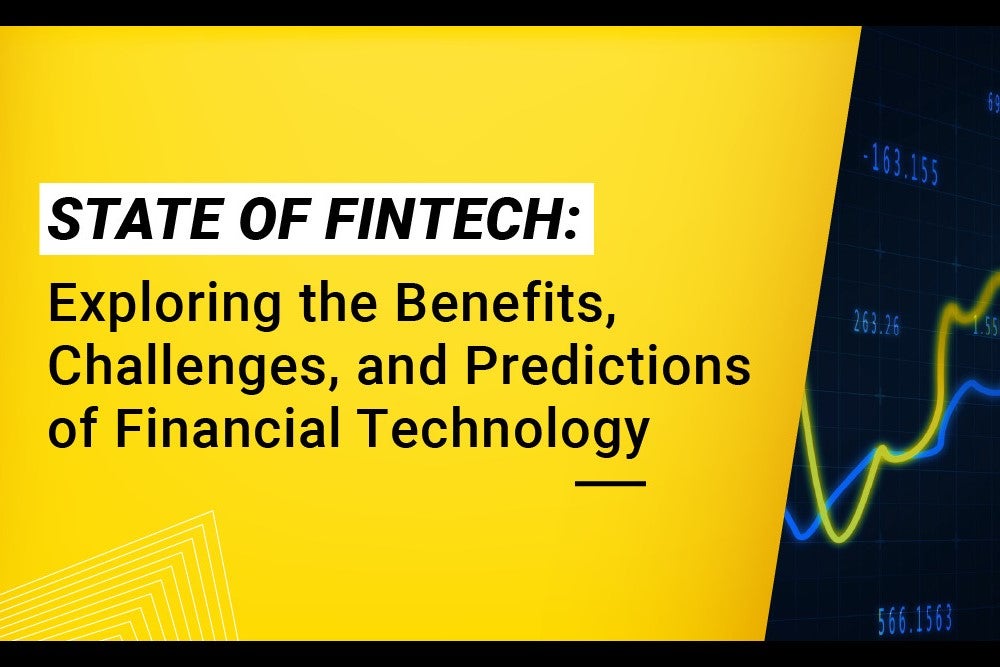5 top fintech companies disrupting the financial landscape

Financial technology (fintech) has come a long way since EFTPOS machines were considered innovative. Now, it provides consumers and businesses with unparalleled options that rival traditional financial delivery methods, including products and services that use artificial intelligence (AI), blockchain, cloud computing and big data – collectively known as the ABCD of fintech.
Fintech, including technologies such as peer-to-peer lending, digital banks, cryptocurrency and digital wallets, have permanently changed the way businesses and customers secure finance, invest and transact for the better. In recent years, the industry has exploded in popularity and value. For example, the total transaction value of digital payments is currently at US$91 billion (AU$145 billion) and the neobanking sector is projected to reach a value of US$703.34 million (AU$1.06 billion) by 2026.
For anyone looking to enter the field, programs like the online Master of Financial Technology from UNSW can prepare you for a successful career in fintech. The program delivers technical financial technology skills across a range of courses to provide you with the confidence to lead and innovate teams, start-ups and businesses. Graduates will also gain an understanding of relevant financial technologies, frameworks and what it means to be an ethical professional in a disruptive and innovative industry.
What is fintech?
‘Fintech’ is technology that aims to improve and automate the delivery of a suite of financial services. It has many uses, including helping companies, business owners and customers manage financial operations and processes by using intelligent software and algorithms.
At its core, fintech is what enables businesses and consumers to perform a range of financial activities, including transferring money, applying for credit and investing in a digital currency, all without human assistance. Fintech now operates in numerous sectors and industries, including education, retail, banking, fundraising and investment management.
Fintech is increasingly common among consumers. According to the EY Global FinTech Adoption Index 2019, one-third of all customers use at least two fintech services.
The purpose of fintech
Fintech receives considerable attention from the media and attracts investment worldwide, with many fintech start-ups receiving billions in venture funding every month. This attention isn’t unfounded. At their core, fintech start-ups are designed to threaten, challenge and eventually take over from traditional financial service providers.
Fintech start-ups can do this by being more agile; by providing services for a previously underserved population; or by providing a better, faster, more transparent service than more traditional financial organisations.
A brief history of fintech
The term ‘fintech’ initially emerged in the early 2000s. At the time, it was used to describe back-end systems of established financial institutions. Today, it has a vastly different meaning.
Around the mid-2010s, fintech exploded in popularity, with many new start-ups receiving millions and even billions in venture capital investment. Fintech start-ups were most prolific in North America, with many also appearing in Asia and Europe.
Fintech grew to include the following technologies:
- Cryptocurrency, including non-fungible tokens (NFTs), as well as blockchain technology and smart contracts.
- Money management tools, including those that enable open banking, in which applications connect financial institutions with third-party providers.
- Insurance technology.
- Roboadvisers, in which algorithms automate investment advice.
- Banking services for people who couldn’t access them before.
- Cybersecurity applications that allowed for the decentralised storage of data.
Fintech users
More and more of the population is adopting fintech in their daily lives. Four main categories of users of fintech exist:
- Business to business within the banking sector.
- Banks serving their clientele within any sector.
- Business-to-consumer services for small businesses.
- Consumer services.
All four categories of users are also increasingly able to interact due to the increased information, data, decentralisation and more accurate analytics now available via fintech.
The demographics of fintech users typically skew younger, with many start-ups targeting millennials and Generation Z. Most customer-oriented fintech start-ups target them because they have high trust in fintech and can use it with ease. The population is also large and likely to inherit considerable wealth in the coming years, making fintech a valuable money management tool.
As users of fintech increase, so has the demand for trained professionals. So much so, that demand for skilled workers far outweighs the talent available. Thankfully, today, there are postgraduate programs, like the 100% online Master of Financial Technology at UNSW, available to help address the needs of the growing industry.
Fintech benefits and risks
Without a doubt, fintech has revolutionised how customers transact and has provided numerous benefits to large segments of the population. Unfortunately, fintech also presents some risks. Below are both the benefits and the risks of fintech.
Benefits of fintech
Fintech offers five key benefits.
Lower prices
As a general rule, fintech products offer considerably lower prices to both customers and businesses. The reasons are complex but are generally the result of less bureaucracy, algorithms that can provide more accurate lending data and the absence of legacy systems that create larger cost bases and risks for organisations.
Better access to financial products
In the past, many groups had little or no access to financial products and lending, for example, small businesses or those with bad credit. Fintech has helped democratise the finance industry, ensuring that small businesses have better access to lending. Customers also have better access and insights into their interest rates, spending and risks through fintech products, including regional customers who may not have been able to visit branches.
Improved transparency
Fintech provides customers with a high level of transparency in what they spend and earn. Fintech products offer real-time insights into spending and in-depth analysis of important metrics, such as where money is spent, when and why. This data can help customers make important financial decisions.
Better service
With improved transparency, algorithms and AI, fintech provides vastly better service than traditional financial institutions. This is largely due to technology, but also due to smarter and faster processes.
Faster service
One of the greatest benefits of fintech is how fast service can be across a vast range of services. As opposed to waiting days or weeks, business customers can secure loans in 24 hours or less. Customers can also access real-time data, enabling them to make fast and informed decisions, or transact, instantly.
Risks of fintech
As beneficial as fintech is, it also presents three main risks.
New, inexperienced entrants
Most established financial institutions worldwide have been around for decades. However, one risk of fintech is that new, inexperienced companies enter the space and may not have the required licences or appropriate experience to run a financial institution. They may also not provide the appropriate documents or financial disclosure statements.
Less regulation
Financial institutions are heavily regulated and for good reason – the potential for fraud is high. However, fintechs are often difficult to regulate, as they operate outside of the traditional financial landscape. One example of this is that some fintechs in the small business loan space don’t require a credit licence to operate, although technically they should have one.
Additionally, in the fintech space, typical consumer laws may not apply, leaving consumers open to many risks. Regulation has become an area of considerable concern for anyone using fintech.
Cybersecurity
With a multitude of sensitive data stored in the cloud, comprehensive cybersecurity in fintech is essential; however, fintech is often a target for attacks.
Fintech products are often the target of malware, data breaches, phishing, cyber fraud and other types of attacks. Sometimes, they’re successful in obtaining sensitive financial information.

Fintech examples
Fintech offers fast and convenient solutions to businesses and customers alike. Below are five different fintech examples.
Digital banks
One fintech example that has helped to revolutionise access is digital banking. Many fintech digital bank start-ups have helped improve access to traditional banking services for those who couldn’t previously access them, due to either their location or the high cost of banking fees.
Digital banks have helped give all people access to banking services.
Small business finance
Small businesses have traditionally had to bear the brunt of loan rejections, with traditional banks often being unable to assess their creditworthiness. This has meant many small businesses being unable to access credit.
Fintech has changed this, enabling small businesses to not only access loans but also do so faster and more securely than in the past, while also enjoying favourable credit terms.
Peer-to-peer lending
Fintech is also revolutionising equity finance. Many different fintech firms are working on solutions to help businesses and individuals more easily raise money outside of the traditional banking system.
In this particular category, some start-ups are focused on aligning investors with deserving businesses that may be just starting out or may need access to additional capital.
Another area of focus for start-ups in the peer-to-peer space is helping businesses and individuals support charities or other worthwhile causes through fundraising. Peer-to-peer lending helps remove the intermediary, typically a bank and enables investors to connect directly with others.
Cryptocurrency
Many fintechs have been pivotal in creating cryptocurrency, a virtual currency that uses encryption technology to offer a secure form of exchange.
Many industries are currently benefiting from cryptocurrency, as it reduces costs, allows for quicker and more efficient transactions, is more easily traceable, improves security and offers increased transparency in online payments. Many online retailers are beginning to accept cryptocurrency as a form of payment.
Digital wallets
The final important fintech example is digital wallets. There’s no limit to what people can do on their smartphones nowadays and fintechs have ensured that this is possible from a payments perspective.
Instead of relying on a traditional wallet with bank cards, fintechs have made it possible to easily and seamlessly transact via smartphone, saving customers time and providing extra security.
Fintech companies disrupting the financial landscape
A plethora of fintech companies are changing everything in finance for the better, so it can be hard to pinpoint just a handful.
However, a few of them have grown considerably and are leaders in their space. Below are five examples of fintech companies disrupting the financial landscape.
Nimble
As one of the early fintech examples of disruption to the traditional loan sector, Nimble began in 2005 as a loan provider that serviced everyone and endeavoured to make the loan process faster, easier and accessible to more people than ever.
Specialising in small loans (up to US$25,000, or AU$36,8500), Nimble offers an online application process, quick decisions and access to loan money within an hour. It has serviced nearly 1.7 million customers.
SocietyOne
As a premier peer-to-peer lending platform, SocietyOne enables investors to reach borrowers and endeavours to provide both a better and fairer deal than they would find via a traditional financier.
Established in 2012, SocietyOne has matched investors’ funds with more than 35,000 consumers and, as of 2021, it had surpassed AU$1 billion in lending.
Prospa
Prospa is a loan provider focusing exclusively on the small business space. Currently, it’s Australia's number one online business lender and it takes pride in understanding what it’s like to be a small business and offering a frictionless experience for all small businesses, regardless of size.
Prospa offers small businesses loans of up to $US500,000 (AU$736,940) and applications can be approved in as little as 10 minutes.
Moula
Founded in 2013, Moula provides loans to small and medium businesses. Its mission is to remove much of the traditional hassle associated with loans, including paperwork, extensive credit checks and onerous financial and data reporting requirements.
Moula offers business customers loans of up to $US250,000 (AU$368,470) and aims to provide a personal service.
Judo
Founded in 2016, Judo Bank is a neobank (a bank that only exists online). Judo competes with larger, more established banks by offering a more seamless and nimble experience to its customers.
Judo has secured an authorised deposit-taking institution (ADI) licence, which means that it can receive deposits from retail and normal customers and offer term deposit products.
Judo also offers a suite of different business loan options.
 Other resources
Other resources
Following are other examples of leading fintechs in Australia:
- Crunchbase, Australia FinTech Companies: This resource provides a listing service that details key statistics for Australian fintechs.
- Tracxn, FinTech Startups in Australia: This resource provides a detailed description of more than 2000 Australian fintechs.
- VCBay, “Top 10 FinTech Startups in Australia”: This resource provides a list of Australia’s top 10 fintech startups.
Future of fintech
As evidenced by the ongoing increase in both business and consumer use, the future of fintech is bright. Below are four key trends to watch for.
Uses and benefits of blockchain will continue to increase
In 2022, the value of cryptocurrencies plummeted, leading some to question whether the blockchain-enabled industry could or would continue in its current form.
Despite the loss, venture capitalists are still investing in blockchain and cryptocurrency projects. This investment includes several billion dollars in decentralised finance (DeFi) platforms, which offer an alternative to the current financial system as they’re open, global and don’t have a central governing body.
These platforms offer users the option to trade, lend, borrow and exchange assets and increasingly may be used instead of standard banking, trading and even currency exchanges.
Regulators will create stricter ordinances for fintech
For as long as fintech has been around, financial regulators have been trying to play ‘catch-up’ to protect businesses and consumers. In Australia and overseas, there have been multiple inquiries into the fintech industry, most notably into the buy now, pay later (BNPL) sector, which has attracted scrutiny.
Regulators are also looking at ways to govern cryptocurrency, as well as evaluate the algorithms and AI functions of fintech apps. As time goes on, fintech will likely involve significantly more regulation.
Fintech will continue to solve credibility issues
One thing that traditional financial institutions have that fintech often doesn’t is the trust of customers. Regarding finance of any type, trust is crucial and fintech has encountered credibility problems, partially because it’s quite new compared with older financial technology. It also isn’t regulated in the same way that traditional institutions are.
It’ll take consumers and businesses time to learn to trust big data, cloud computing and fintech in general. As it becomes more mainstream and sophisticated, its credibility will increase.
Fintech will reach more customers than ever before
Fintechs may soon be so widespread that more people will be using them than traditional banks. This will likely happen first with people who are unable to reach banks’ physical branches or those who have traditionally not been able to afford banking services.
Over time, however, the growth will likely spread to all or almost all customers who require banking services. Consumers will see that fintech offers speed, security, convenience and transparency in a way that traditional banking simply doesn’t.
Other resources
Below are resources with more information on the future of fintech.
● Research-Technology Management, “The Future of Fintech”: This resource is an academic article on what to expect in the future from the fintech industry.
● Bank Director, “Top 5 Fintech Trends, Now and in the Future”: This resource presents the top five fintech trends in 2022.
● BrightTALK, “The Future of Fintech: 2022 and Beyond”: This resource contains webinar presentations from a June 2022 virtual summit covering fintech’s evolution.
The future of fintech is bright
Technology has disrupted practically every industry, from farm machinery to publishing. However, the financial industry has seen one of the most widespread and beneficial disruptions in fintech.
Fintech has helped revolutionise and democratise finance, both in terms of who can access it and who has the information to make the most informed decisions. Fintech helps provide frictionless access to financial products, meaning more businesses and ultimately more people can be financially successful.
If you’ve been thinking about a career in fintech, programs like the online Master of Financial Technology from UNSW can give you the competitive edge and skills to stay ahead of the curve in this disruptive industry.
Speak with our team of Student Enrolment Advisors to learn how you can be a part of the booming fintech industry with the 100% online Master of Financial Technology at UNSW.

 Other resources
Other resources 







